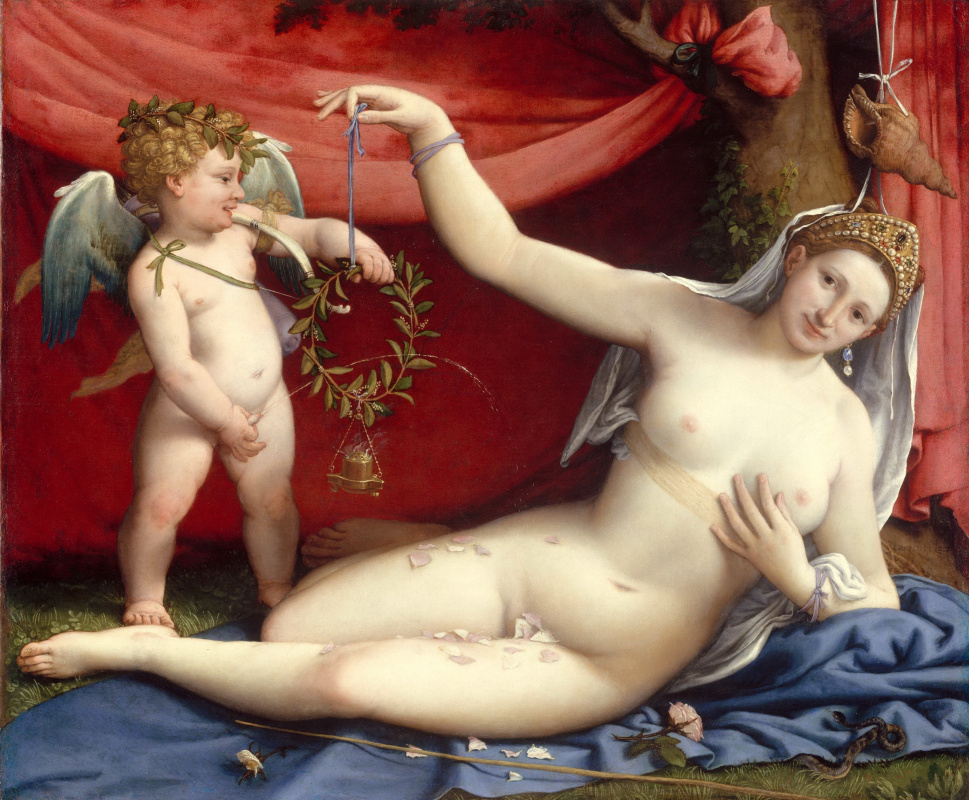log in
Enter site
Login to use Arthive functionality to the maximum
Venus and Cupid
Lorenzo Lotto • Painting, 1525, 92.4×111.4 cm
Description of the artwork «Venus and Cupid»
Lotto is one of the most interesting, versatile and distinctive artists of the Italian Cinquecento. The circumstances of the order of this work are unknown. Perhaps the picture was painted at the request of the nephew of the artist Mario d'Armano. The scene, typical of seemingly for Lotto, seems to be rather complicated from the iconographic point of view, providing opportunities for many interpretations. The simplest is the one that interprets the work as an allegory of happiness: the iconographic structure of the work, presumably written on the occasion of the wedding, directly corresponds to the classical epital.
The composition is dominated by the figure of Venus (its portrait resemblance to the bride is not excluded), whose head is crowned with a magnificent diadem with a wedding veil. The shell, rose petals, which seemed to have just landed on her bosom, and myrtle are classic symbols that identify the goddess. Other details of the composition are associated with love and fidelity: myrtle garland and censer, red cover, ivy. Cupid pees through a myrtle wreath, which means wishes for fertility and a happy fate for the union.
In the foreground is a snake, almost invisible among the folds of drapery, on which Venus lies. Some tend to associate it with a sense of jealousy. But according to ancient beliefs, this reptile was a phallic symbol associated with Mother Earth, and is here an allegory of happiness and fertility.
In the background, behind the head of Venus, attention is drawn to the sprouts of ivy that has encircled a tree. The main characteristics of climbing plants is that they are evergreen and grow by “hugging” tree trunks. Ivy was associated with manifestations of love and friendship, becoming a symbol of fidelity and eternal love.
The artist was able to wonderfully display the daring expression and craftiness of Cupid. On the head of the faithful companion of Venus is a wreath from myrtle (sacred to the goddess of the plant), revered in antiquity as a symbol of fertility. This interpretation is supported here by the gesture of a divine boy, which marks a happy and fruitful union.
The composition is dominated by the figure of Venus (its portrait resemblance to the bride is not excluded), whose head is crowned with a magnificent diadem with a wedding veil. The shell, rose petals, which seemed to have just landed on her bosom, and myrtle are classic symbols that identify the goddess. Other details of the composition are associated with love and fidelity: myrtle garland and censer, red cover, ivy. Cupid pees through a myrtle wreath, which means wishes for fertility and a happy fate for the union.
In the foreground is a snake, almost invisible among the folds of drapery, on which Venus lies. Some tend to associate it with a sense of jealousy. But according to ancient beliefs, this reptile was a phallic symbol associated with Mother Earth, and is here an allegory of happiness and fertility.
In the background, behind the head of Venus, attention is drawn to the sprouts of ivy that has encircled a tree. The main characteristics of climbing plants is that they are evergreen and grow by “hugging” tree trunks. Ivy was associated with manifestations of love and friendship, becoming a symbol of fidelity and eternal love.
The artist was able to wonderfully display the daring expression and craftiness of Cupid. On the head of the faithful companion of Venus is a wreath from myrtle (sacred to the goddess of the plant), revered in antiquity as a symbol of fertility. This interpretation is supported here by the gesture of a divine boy, which marks a happy and fruitful union.


